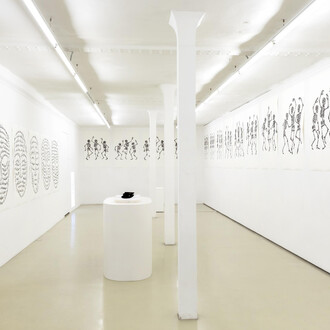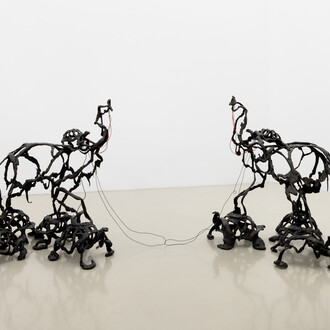For his second solo exhibition at Galerie Krinzinger, Western beef, Anthony Olubunmi Akinbola continues to repurpose everyday objects to explore the relationship between ubiquitous commodities and their broader socio-political connotations, an artistic strategy previously employed in his signature Camouflage series, in which durags are used as a textile medium that bridges painting and sculpture. Through the use of readymade objects and various modes of display, often with a playful twist, Akinbola, a first-generation American raised in both the United States and Nigeria, reflects on issues of race, the commodification of culture, and mass production. Central to his latest exhibition are the ways in which products or objects contain power or significance beyond their assumed use, and how relationships along cultural divides, as well as between individuals, are mediated through commodities. “I persist in investigating the dynamic value of objects pervasive in our everyday lives; how the identity of these objects fluctuates over time and through communities is always changing, never static”, states the artist.
Akinbola borrows this exhibition’s title, Western beef from a low-cost supermarket chain located mostly in ethnically low-income, inner-city neighbourhoods of New York City that have been neglected by other supermarket stores; the chain has a significant focus on extensive, affordable meat departments. The exhibition reconstitutes the exchange of literal and figurative exports between Africa and the West through the mediums of painting, sculpture, and installation. As viewers navigate the exhibition, they witness the transformation of African cultural products—whether celebrated, consumed, or commodified—within the maelstrom of global industry. At which moments does a national product become elevated or denigrated by migration? Is a goat better embodied by a wooden effigy or its skin rotating by conveyor?
The question of the “fetish” has lately been a central concern for the artist. A “fetish” can refer to objects, rituals or practices imbued with a particular symbolic or spiritual significance, in addition to certain psychological or sexual fixations. In a more casual or colloquial sense, the term “fetish” can be used to describe any strong or unusual preoccupation or fixation with something. “Goats are highly fetishized animals where I come from,” says Akinbola. In many Nigerian communities, especially in rural areas, the ownership of goats is a sign of wealth and prosperity; goats are considered valuable livestock, and their presence in a household can signal economic stability. They are often given as gifts at traditional ceremonies such as weddings to symbolise abundance and wealth, and play an important role in religious rituals and ceremonies, sometimes finding their purpose as sacrificial offerings.
A herd of fifteen intricately carved wooden goats, Manikin 1–15 (2024), each unique and crafted by Nigerian artisans, quietly inhabits the gallery space. These sculptures, embodying both the livestock central to Nigerian life and the essence of Nigeria itself, become symbolic ‘livestock’ within the gallery, reflecting the complexities of cultural export. Stripped of their original context, they are no longer objects of utility but rather emblematic figures—at once authentic and hollow— destined to graze eternally in their new, inert purpose. Amongst these facsimiles is one that is not like the others; it has a face that resembles the artist, and insinuates his own experience of objectification and transformation.
“I work with what is accessible to me and I often collect material before I find a purpose for it. I might have something sitting in the studio for months or years before it is used, if at all. I feel my work is half play, half critical thinking, and you end up at a destination eventually”, explains Akinbola. Working with a variety of everyday materials and familiar resources, from shiny textile durags and palm oil to plastic bags and hairbrushes, Akinbola is interested in the tactility, visage, and even the scent of different materials; in Raw potential (2024), he incorporates leather, produced in Nigeria and imported to the USA and Europe, that is used by many high- end brands; a material charged with meaning and situated at the crossroads of various cultural, ethical and environmental discussions, leather can be tied to a history of “exoticizing” non- Western cultures, where materials like animal skins were used to depict Indigenous or African people in Western media, often in stereotypical or dehumanizing ways; leather holds a deep symbolic significance also in relation to race. In his new series, Butcher 1–7 (2024), Akinbola combines linen canvases with wrought-iron butcher hooks. The utilitarian purpose of the hooks is in question; whereas they were once lining the walls of a butcher shop, covered with bodies of animals subjected to slaughter, they now operate as formal gestures within paintings. Affixed to raw linen, each empty rack now delineates a surrealist purpose in the absence of what was there before.
Across the gallery, a solitary garment conveyor decorated with goat hides rotates in perpetuity as a meditation on the perils of industrialized consumption; Carousel (2024) speaks to the flattening of all living things in the relentless cycle of globalized industry. The objects in rotation have been decapitated, efficiently and violently commodified, and they float through the gallery in endless, mechanized purgatory. The installation confronts viewers with the stark reality of how cultural and material exports are consumed, transformed, and dehumanized in the pursuit of profit.
“Western Beef is both a comparison-between and marriage-of abstraction and industrialization, reflecting global phenomena and my own personal engagement with the cultural bloodline connecting Africa and the West”, comments Akinbola. Viewers are challenged to consider how symbolised animals and ethno-specific artifacts become both objects of idolatry and subjects of slaughter, mirroring the complex dynamics of cultural consumption. Through the act of appropriating found objects, recontextualising symbols and making bold gestures, Anthony Akinbola explores how identity is consumed and how agency can be reclaimed within the global flows of capital and culture.
(Text by Hana Ostan-Ožbolt-Haas, 2024)
















